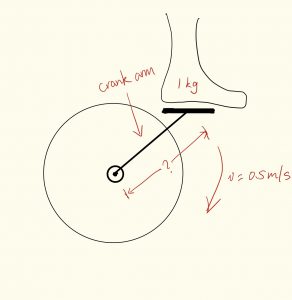IDENTIFY:
Cycling is a type of popular cardio exercise that can be widely seen in gym, home, and outdoor. This exercise allows exerciser to expend energy by rotating feet around the center of flywheel. Generally, the work done by exerciser just transfer to heat and lost in the air, but can we store the energy and utilize it for our daily life? The answer is yes. In article These Exercise Machines Turn Your Sweat Into Electricity fromIEEE spectrum, it states that Harr, a 21 year old mechanical engineering graduates of University of Florida developed that energy conservation device [1]. By converting workout energy to electricity, electrical bill can be reduced. At the same time, it encourages people to do more exercise to achieve a healthier life. In order to make a real cycling machine to meet this demand, engineers need to identify, formulate, and solve problems. For example, a question would be how long the crank arm of the cycling machine should be in order to generate 6000 Joules energy in a hour (100watts) ? This question need to be solved because it makes more sense if the machine can generate noticeable amount of energy. The unknown is the crank arm length, and variables are rotating speed of exerciser and exercise duration, which can be assumed as 0.5 m/s and 1 hour, and the work expected is 6000 joules. By solving this problem, engineers would be able to design the machine with proper crank arm length.
Figure 1[2]. This picture express someone is recycling workout energy to lighten bulbs.
FORMULATE:
Figure 2. This hand drawing express the flywheel and crankarm park on a normal bike.
Assumptions and Simplification:
(1) The weight of the exerciser’s feet is 1kg (Assume 70kg*1.45%*2)[3]
(2) exerciser’s feet are rotating in a constant speed of 0.5 m/s
(3) The generated energy expected in 1 hour is 6000J (100 watts)
The problem is to solve the length of the crank arm of this cycling machine (the radius of this circular motion).
Equations for circular motion and work: ![]()
SOLVE:
Since we expect work done is 6000 Joules in a hour, and distance is 0.5 m/s * 3600 s = 1800m,
F = W/d = 3.3 N
F = 3.3 N = (mv^2)/r = (1kg*1m^2)/r
=> r= 1kg*m^2/3.3 N = 0.3 m
Thus, as assumptions made above, the radius of the crank arm of the cycling machine should be about 30 cm, which is realistic.
The variables like feet weight (directly related to force applied on pedal), and rotating velocity can be various for different user. Thus the energy generate can be different for different user too. Generally, more force input the exerciser do, the more the energy generated, and faster the exerciser rotate their feet, the more the energy generated.
One major limitation need to be concerned for this design is that the energy generated won’t be 100% converted to electricity. Thus there is more problems need to be solve to make the conversion more efficient.
Overall, the length of the crank arm of the cycling machine should be about 30 cm in order to generate 6000 joules per hour (100 watts). The solved length is a reasonable value. The energy generated for a single cycling machine might not be a lot, but it can be a more significant number if the system is utilize by gym on multiple cycling machines.
Path forward: instead of a in home exercise device, it can be further designed as a portable energy conservation system attached to a real bike that cycling work can be conserved into battery. In addition, not only cycling machine, the energy recycling system can be applied on other type exercise machines with similar mechanism.
More to read:
Could We Use Exercise Machines As Energy Sources?




I just used a machine like this with an organization that reaches out to homeless community members in Detroit. They use bikes like these to generate power for a paper shredding plant! Awesome idea!